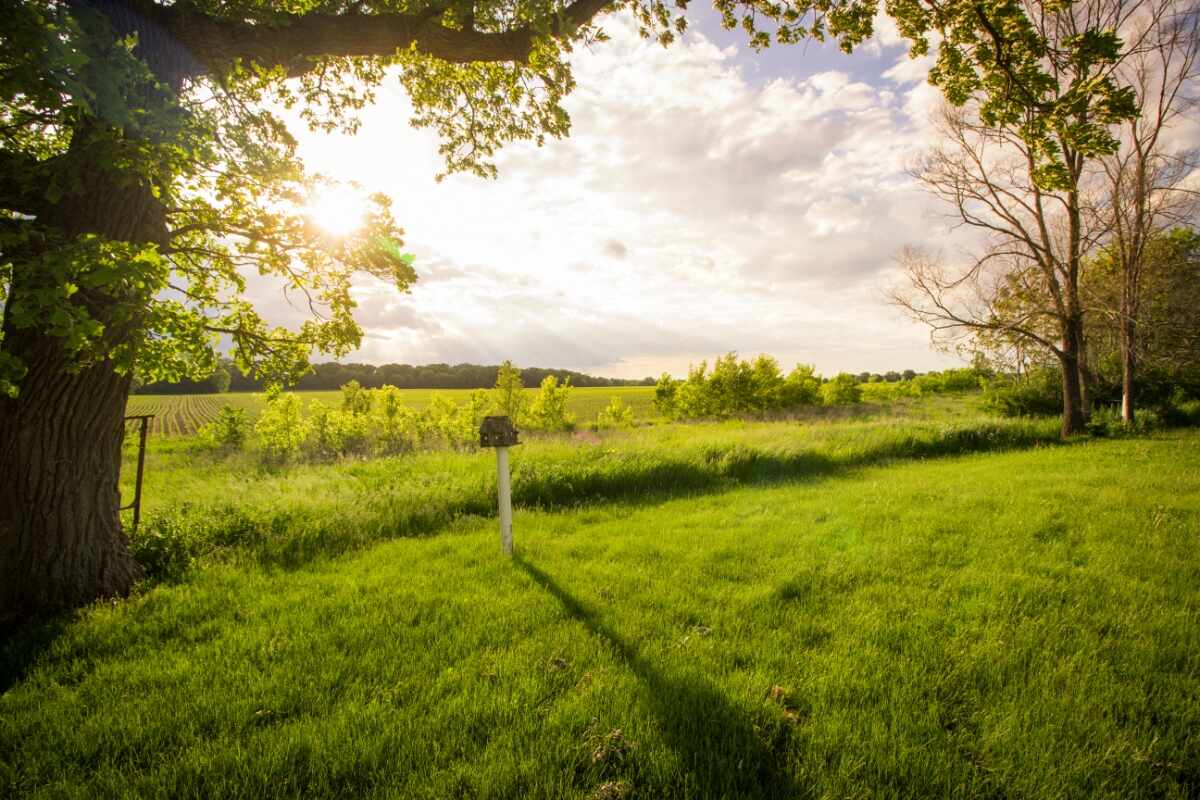
The Midwest offers a distinct dance of cold winters and hot, humid summers, making lawn care a lively challenge. Unsurprisingly, cool-season grasses fare best here, showing off their lush greens in cooler months and taking a summer siesta when the heat kicks in. But, considering the vast tapestry that is America’s heartland, it can be hard to pin down the best grass seed for the Midwest.
The best grass type for your Midwestern lawn lies in the details. The richness of the soil, sunlight levels, and the amount of rainfall your region receives are your guiding stars. So, let’s embark on this lawn improvement journey together and uncover the right grass seed for your personal Midwest oasis.
What is the Best Grass Seed for the Midwest?
Whether you’re giving your existing lawn a makeover or starting from scratch, it’s all about knowing the best grass seed for your needs and local climate. In the Midwest, with its variable weather, cool-season grasses are the way to go. Grasses such as fescues, ryegrass, and Kentucky bluegrass are all Midwest mainstays.
However, these grass seeds aren’t created equal – each has a unique fighting style. Learn about each one’s quirks and characteristics below.
Kentucky Bluegrass
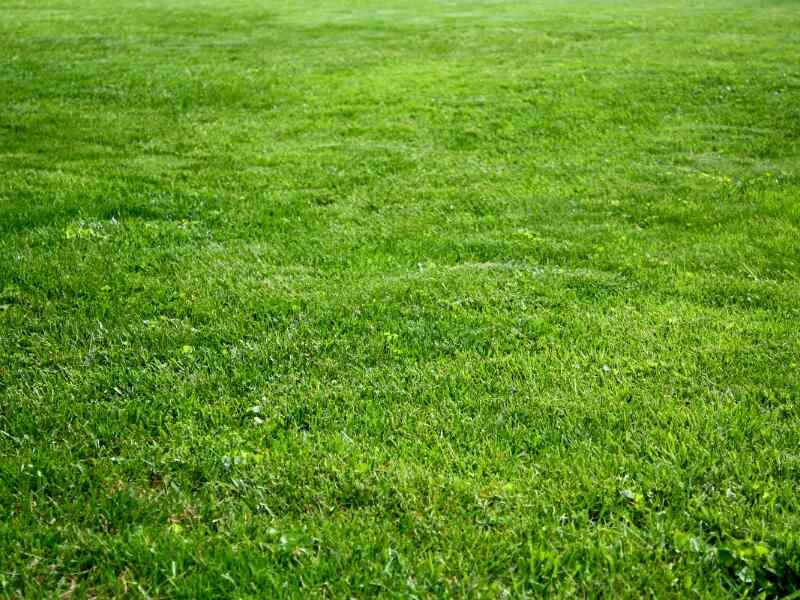
A crowd favorite, this cool-season grass shines bright in the Midwest. Known for its rich blue-green hue, Kentucky bluegrass establishes itself fast and recovers quickly from wear and tear. Though it loves sunlight, it can handle partial shade.
When Mother Nature turns up the thermostat, this grass gracefully slips into dormancy, patiently waiting for cooler temperatures to flaunt its colors again.
Just remember: to keep it at its best, it asks for regular mowing, watering, and a touch of fertilizer. Considering a shady spot? Blend in some fine fescue seeds to keep the lawn looking lush.
Key Points:
- Classification: Cool-season grass
- Spreads by: Rhizomes
- Shade tolerance: Low
- Drought tolerance: Moderate
- Foot traffic resistance: Moderate
- Mowing height: Set mowing height between 2.5 and 3.5 inches.
- Potential for disease: Moderate to high; prone to several diseases, such as dollar spot, leaf spot, necrotic ring spot, summer patch, and stripe smut.
- Soil pH: 6-7.5
- Soil type: Performs best in well-drained, heavy soils with high fertility.
- Maintenance needs: High – For a thriving lawn, fertilize between late August and early October and again in May and early June. Kentucky bluegrass requires 3-6 lbs. of nitrogen per 1,000 sq. ft. annually. Mow moderately, but fertilize generously!
Grass Seed Options:
– Jonathan Green (11970) Blue Panther Kentucky Bluegrass Grass Seed (3 lbs.)
– SeedRanch Midnight Kentucky Bluegrass Seed (5 lbs.)
– Jacklin Seed – Biltmore Blue Blend – 100% Kentucky Bluegrass (5 lbs.)
Fine Fescue
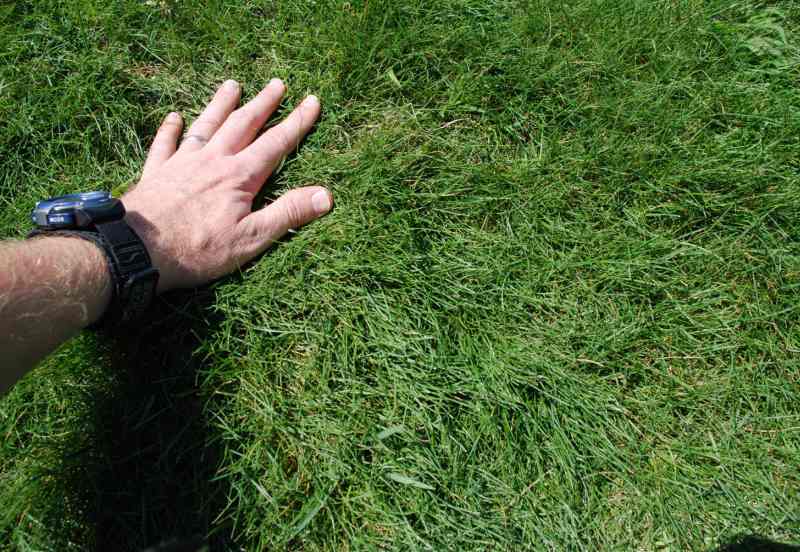
With a name that sounds delicate, fine fescue is anything but. It’s robust, versatile, and can proudly claim a strong foothold in the Midwest’s turf scene. This grass is like that quiet, dependable friend who’s always there when you need them. Fine fescue thrives in areas where Kentucky bluegrass struggles, making it an excellent choice for those shady corners of your yard. These two grass types are often found together in sun-shade mixes.
Fine fescue has several varieties, including creeping red, Chewings, sheep, and hard fescue. It tends to have a finer texture than other grasses, and its deep root system allows it to be pretty drought-tolerant. Plus, if your lawn has poor soil, fine fescue is your best friend. It’s not too picky about the land it grows in.
One downside? It’s not a fan of high foot traffic, so if your yard is where all the neighborhood kids hang out or the main stage for weekend BBQs, you might want to mix it with more traffic-tolerant grass seeds.
Pro Tips:
- Mix fine fescue with Kentucky bluegrass and perennial ryegrass for optimal growth in partially shaded lawns.
- Opt for creeping red fescue if you’re after a stand-alone grass with a distinctive texture.
- Pair hard and Chewings fescues with other grass varieties for a more diverse lawn appearance.
Key Points:
- Classification: Cool-season grass
- Spreads by: Creeping red fescue – by rhizomes; but Chewings, hard, and sheep fescues are bunch-type and don’t spread
- Shade tolerance: High. Perfect for those spots beneath trees or shaded areas.
- Drought resistance: Moderate to High. Pretty good, thanks to its deep roots.
- Foot traffic tolerance: Low
- Mowing height: 2.5 to 4 inches
- Potential for disease: Low to Moderate. This grass is hardy and doesn’t easily succumb to diseases. Common diseases include red thread, leaf spot, dollar spot, summer patch, and powdery mildew.
- Soil pH: 6-6.5
- Soil type: Flexible. Doesn’t do well in wet soil; prefers well-drained soils that are rocky, sandy, or clayey
- Maintenance needs: Low to moderate. It’s relatively low maintenance compared to Kentucky bluegrass. A bit of watering and occasional mowing, and you’re golden! For fine fescue, fertilize in early to mid-September with 0.5-1.0 lbs of nitrogen per 1,000 square feet. Opt for a slow-release fertilizer.
Grass Seed Options:
– Outsidepride Legacy Fine Fescue Grass Seed (5 lbs.)
– Eretz Creeping Red Fine Fescue Seed (choose your size)
– Outsidepride Creeping Red Fine Fescue Grass Seed (25 lbs.)
– Outsidepride Hard Fine Fescue Grass Seed (10 lbs.)
Perennial Ryegrass
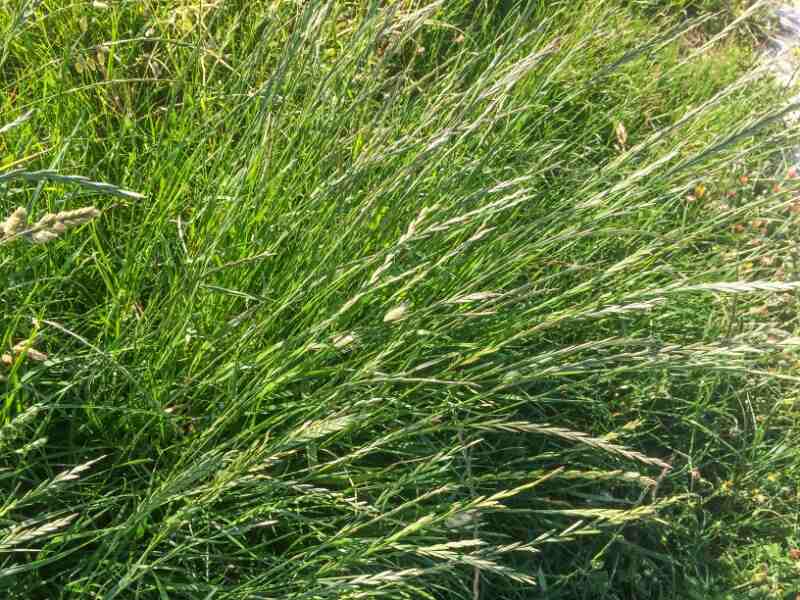
Perennial ryegrass is the knight in shining armor for many lawn enthusiasts. A super-fast germinator, this grass type is the quick fix for bare patches and can often be seen tagging along in mixes to give that quick cover while other grasses take their sweet time to establish.
Distinguished by its vibrant green color, perennial ryegrass establishes a thick turf resilient to foot traffic – be it from children, pets, or regular outdoor activities. However, its absence of rhizomes and stolons means it doesn’t spread as widely on its own, which can sometimes result in sparse areas on your lawn.
Furthermore, it might not fare as well in the intense cold of Midwest winters compared to some other cool-season grass varieties. So, blending it with other cool-season grasses like Kentucky bluegrass or fine fescue can give you the best of both worlds – quick establishment and lasting durability.
Pro Tip: While you won’t see much thatch buildup with perennial ryegrass, keeping it in tip-top shape means giving those roots some breathing room! Remember to aerate the lawn each fall to ensure they get the air they need.
Key Points:
- Classification: Cool-season grass
- Spreads by: Bunch-type grass; does not spread
- Shade tolerance: Low. It prefers full sun.
- Drought resistance: Moderate. It likes its water! You’ll need to keep an eye on it during drier spells.
- Foot traffic tolerance: High. It can handle a little rough and tumble.
- Mowing height: 1-1.5 inches.
- Potential for disease: Moderate to high. Watch out for red thread and gray leaf spot.
- Soil pH: 5.5-7.5
- Soil type: It’s not picky but thrives in well-draining soil.
- Maintenance needs: Moderate. This isn’t a set-it-and-forget-it grass. Regular mowing and a sprinkle of water will keep it tip-top. Feed it 1-5 pounds of nitrogen per 1,000 square feet per year, ideally in late August to early September.
Grass Seed Options:
– Outsidepride Perennial Ryegrass Seed (5 lbs.)
– Eretz ProTurf Perennial Ryegrass Fine Lawn Seed (choose your size)
Tall Fescue
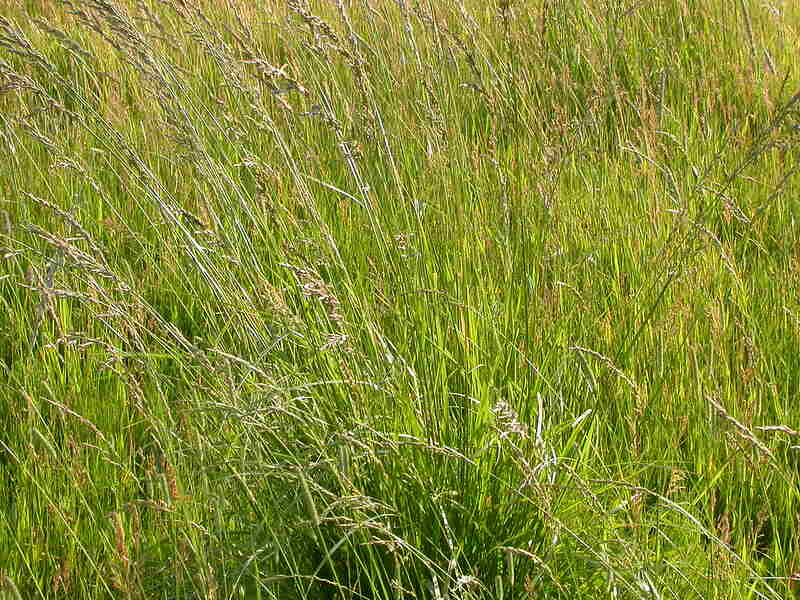
Tall fescue is certainly making waves in the Midwest. With its signature dark-green hue and wide blades that set it apart from other grasses, it’s hard to miss. This turfgrass stands out for its leafy texture and impressively deep roots, characteristics that make it perfect for cooler climates.
Tall fescue grass is a resilient choice for the Midwest, especially with summers that can sometimes turn unbearably hot. Thanks to its robust root system, tall fescue absorbs nutrients and water more efficiently than most cool-season grasses. This means it’s less prone to diseases and can effortlessly mend itself.
However, it’s not without its quirks. Though it can withstand quite a bit, one of its vulnerabilities is the formation of bare patches during intense heat waves, particularly when the climate remains both dry and humid for extended periods. For this reason, it’s best to blend tall fescue with other cool-season grasses like Kentucky bluegrass for a balanced lawn.
Key Points:
- Classification: Cool-season grass
- Spreads by: Clumping growth pattern
- Shade tolerance: Moderate. It’s a versatile player and can tolerate some shade.
- Drought resistance: Moderate to High. Those deep roots surely do wonders!
- Foot traffic tolerance: Moderate. It can handle your Sunday family picnics, but maybe not a full-on football match.
- Mowing height: 3 to 4 inches. Thanks to its slow growth, you don’t need to mow every other day. Minimal thatch build-up.
- Potential for disease: Low
- Soil pH: 5.8-6.5
- Soil type: Adaptable but prefers well-drained soils
- Maintenance needs: Moderate. A bit of TLC, and this grass will be your lawn’s shining star. Fertilize with 2-4 lbs. of nitrogen per 1,000 sq. ft. annually, preferably in early fall.
Grass Seed Options:
– Triple-Play Tall Fescue Grass Seed Blend (5000 sq ft)
– Eretz Kentucky 31 K31 Tall Fescue Grass Seed (choose your size)
– Pennington The Rebels Tall Fescue Grass Seed Mix (7 lb.)
Exploring Alternative Types of Grass Seeds for the Midwest
Many Midwesterners love their perennial ryegrass, Kentucky bluegrass, and fescue grasses for their green havens. But there are other turf types that, though not as popular, still offer great features and an enviable look. These options even include some warm-season grasses!
Bentgrass
Often reserved for golf courses, bentgrass is a cool-season grass known for its fine texture and ability to withstand close mowing. Its carpet-like growth makes it a top choice for putting greens, where it can be mowed down to an impressive 1/8-inch.
Though it offers a polished look and is well-suited to the Midwest’s cool and moist conditions, it demands high maintenance. In a home lawn setting, this can mean more frequent watering, mowing, and susceptibility to lawn diseases if not carefully managed. It’s also worth noting that bentgrass is not particularly drought-tolerant and can quickly turn brown during dry spells.
Key Points:
- Classification: Cool-season grass
- Spreads by: Stolons, giving it a creeping growth pattern
- Shade tolerance: Moderate
- Drought resistance: Low. It requires regular watering to maintain its luscious look.
- Foot traffic tolerance: Moderate. Though resilient, excessive foot traffic can damage its fine blades.
- Mowing height: As low as 0.125 inches for golf greens but 0.5 to 1 inch for home lawns.
- Potential for disease: High. Common issues include dollar spot, brown patch, and leaf spot.
- Soil pH: 5.5-6.5
- Soil type: Prefers well-drained, sandy soils.
- Maintenance needs: High. Its fine texture and growth pattern demand regular mowing, fertilization, and disease management.
Buffalograss
Buffalograss is a native prairie grass and is one of the primary grasses of the Great Plains of Kansas, the Dakotas, and Nebraska. Being native to the region, it is well-suited to the Midwest’s varying conditions. It’s a warm-season grass, which means it will be most vibrant during the summer months.
One of the major selling points of buffalograss is its low maintenance needs. It requires very little water, making it relatively drought-tolerant. Its natural growth habit is to remain quite low, so it doesn’t need frequent mowing. With a distinct gray-green hue, buffalograss is ideal for a low-maintenance and beautiful lawn.
Key Points:
- Classification: Warm-season grass
- Spreads by: Stolons
- Shade tolerance: Low. Prefers full sun.
- Drought resistance: High. Known to survive extended dry spells.
- Foot traffic tolerance: Low to Moderate.
- Mowing height: Can be left to grow naturally or mowed to about 2 to 3 inches.
- Potential for disease: Low
- Soil pH: 6.5-7.5
- Soil type: Adaptable but prefers clay soils
- Maintenance needs: Low. A true set-it-and-forget-it grass for those who prefer a more natural-looking lawn. Requires weed control.
Grass Seed Options:
– Everwilde Farms Buffalograss Seeds (1 lb. of seeds)
– Scotts Pursue Buffalograss with Natural Seed (1 lb. of seeds)
– Outsidepride Perennial Buffalo Grass Seed (2 lb. of seeds)
Zoysiagrass
While primarily known as a grass for the southern states, some cultivars of Zoysiagrass can fare well in the Midwest, especially in areas of the transition zone. Zoysiagrass is a warm-season grass, so it will be green during the summer and turn brown during the cooler months.
It’s a dense grass, which makes it very effective at choking out weeds. However, it has a slow growth rate, meaning it can take some time to establish.
Heads up: While Zoysia is indeed a charmer, it also has a bold spirit! It can be a bit adventurous and spread its wings. To ensure it doesn’t conquer territories beyond its welcome (like your flower beds or vegetable garden), plant it in well-defined areas or set clear boundaries, such as landscape edging or border plants.
Pro tip: Consider sowing or overseeding your Zoysia between fall and early spring. This is the ideal time as both soil and air temperatures are on the cooler side, making it less conducive for immediate germination.
Key Points:
- Classification: Warm-season grass
- Spreads by: Both rhizomes and stolons
- Shade tolerance: Moderate. Can handle some shade but prefers full sun.
- Drought resistance: High
- Foot traffic tolerance: High
- Mowing height: 1 to 2 inches
- Potential for disease: Moderate
- Soil pH: 6.0-6.5
- Soil type: Adaptable to various soils.
- Maintenance needs: Moderate. As spring emerges, it’s time to play defense. Apply a pre-emergent herbicide to ensure those pesky weed seeds don’t stand a chance at sprouting in your new lawn.
Grass Plug and Seed Options:
– Zoysia Plugs (50 Large Grass Plugs)
– Zoysia Plugs (50 Full & Lush Grass Plugs)
– Zoysia Plugs (100 Plugs)
– Zoysia Emerald Grass Seeds (1/8 lb. of seeds)
– Zenith Zenith Grass Seeds (1/8 lb. of seeds)
Understanding the Midwest: Regions, Climate, and Soil
Before you buy grass seed or roll out the sod, it’s important to get familiarized with your terrain. Why? In nature’s playground, the right answers are determined by the environment. Often referred to as the “Heartland” of America, the vast Midwest region stretches across many states, each with its own unique flavor and, by golly, weather quirks.
Generally speaking, the Midwest experiences a continental climate with no ocean influence. That means wide temperature swings from season to season and double-digit hot and cold records throughout the year. Summers, especially in lower latitude zones, can feature tropical heat with high humidity, while wintertime brings brutally cold temperatures and snow.
Geographic Dive: A Tale of Two Divisions
The Midwest stretches from the East North Central zones of the Great Lakes states to the West North Central’s Great Plains states. Navigated by two colossal rivers, the mighty Mississippi and “Big Muddy” Missouri, this vast region comprises:
West North Central States:
East North Central States:
Climate Intricacies
Climate nuances can be noted based on location. For instance, areas bordering the South enjoy milder winters compared to the northern territories. Eastern parts of the Midwest also tend to be rainier than their western counterparts.
The climate owes a significant chunk of its temperament to the Gulf of Mexico. Warm, moist air rising from the Gulf showers areas in its path with extra warmth and humidity. Conversely, the cold, dry air from the Rocky Mountains and Canada slashes across the Great Plains. When these contrasting air masses collide, expect some theatrical weather displays – the Midwest’s infamous thunderstorms and tornados stand testament to this!
Soil – The Heartland’s Pride
Among the Midwest’s treasures is its soil – rich, well-balanced, and just the right kind of fertile. It’s a dream for anyone looking to cultivate a green thumb, making it a prime spot for enviable lawns. It’s no wonder the region is a patchwork of verdant farms, with corn and soybeans stretching as far as the eye can see.
Here’s a snapshot of what the Midwest climate entails:
- Average yearly temperature: Approximately 50°F
- January lows: Around 15°F
- July highs: Up to 85°F
- Annual rainfall: Between 20 and 47 inches, depending on the region.
- Snowfall: The further north you go, the more you’ll see!
- USDA Plant Hardiness Zone: Mostly between hardiness zones 5 and 6, but ranges from 3a to 7a.
How to Choose the Right Grass Seed for Your Midwestern Lawn
Choosing the right grass seed for a Midwestern lawn requires consideration of your specific climate, soil type, and desired use for the lawn. Here are a few essential factors to help you make an informed decision:
- Determine your lawn’s primary use:
- High Traffic: If your lawn will be used frequently by kids, pets, or for sports, you’ll need a durable grass variety.
- Aesthetics: For lawns that are more for show or low foot-traffic areas, fine-textured grass may be preferred.
- Understand the climate: The Midwest experiences cold winters and warm summers. Some areas may also have drought conditions during the summer. Get a grass type that can survive your town’s lowest winter temperatures, highest summer temperatures, and level of rainfall.
- Consider your soil type: Grasses vary in their tolerance to different soil types, such as clay, loam, or sandy soils. Test your soil to determine its pH and type before choosing a grass type.
- Consider shade vs. sun: For sunny areas, Kentucky bluegrass, perennial ryegrass, and tall fescue are good choices. For shaded areas, consider fine fescues.
- Maintenance preferences: If you want a low-maintenance lawn, you might consider tall fescue due to its drought and disease resistance. If you’re okay with more intensive care, Kentucky bluegrass offers a lush, thick lawn with a beautiful color.
- Evaluate disease resistance: Check grass seed labels for disease resistance, especially if you know certain lawn diseases are prevalent in your area.
- Common grass types for the Midwest – Quick recap:
- Kentucky Bluegrass: A popular choice for many homeowners, it has a beautiful blue-green color, good disease resistance, and establishes quickly. It’s suitable for most of the Midwest but might need supplemental irrigation during dry spells.
- Perennial Ryegrass: Fast to establish and can tolerate high traffic. It’s often mixed with Kentucky bluegrass.
- Fine Fescues: These include creeping red fescue, Chewings fescue, hard fescue, and sheep fescue. They’re shade-tolerant and can thrive in various soils, but they might not be as traffic-tolerant.
- Tall Fescue: Drought and heat-tolerant, this grass has a deep root system. It’s great for areas in the Midwest with hot summers and occasional droughts.
- Mixes and blends: Consider grass seed mixes (combinations of different types of seeds) or blends (combinations of varieties of a single species). These combinations can help maximize the strengths of each grass type and offset their weaknesses.
FAQ About Midwestern Turfgrass
In the Midwest, the ideal time to plant grass seed is during the early spring or early fall. Spring seeding can typically begin when soil temperatures consistently reach 50 to 65°F, which is often in late April to early May. Fall seeding should be done in late August to mid-September, ensuring the grass has enough time to establish itself before winter.
If you’re in the Midwest and prefer an easygoing lawn, buffalograss is a top pick, especially if you’re from places like Kansas or South Dakota. It’s native and tough, perfect for the local weather. But if you’re spread out in the Midwest, fine and tall fescues have your back. They offer quick and sturdy coverage. Just remember, every lawn likes a little love now and then!
For a shady spot in your lawn, consider using fine fescue. Its deep roots resist drought, and it thrives in shade. To handle wear and tear, mix in some Kentucky bluegrass.
Lawn Care Pros in the Midwest
Navigating Midwest lawn care can be challenging due to its ever-changing weather patterns. Popular grass options like Kentucky bluegrass, fine fescue, or perennial ryegrass might be your best fit, depending on your lawn’s unique needs. And for those in the transition zone, don’t overlook the potential of Zoysiagrass.
To make the best choice, evaluate your lawn’s soil quality, local climate, and how much effort you will put into maintenance. With a bit of research and perhaps a blend of these grasses, you’ll discover the perfect green carpet for your home. Nature has a way of keeping us on our toes, but choosing the right grass seed can make all the difference.
Beginning your lawn care journey can be overwhelming, but a specialist is always ready to guide you. Across the Midwest, LawnStarter can link you with a nearby lawn care specialist to plant your new lawn and ensure your yard remains resilient and vibrant, no matter what the Heartland conditions may be.
LawnStarter participates in the Amazon Services LLC Associates Program, an affiliate advertising program. LawnStarter earns revenue from products promoted in this article.
Main Photo Credit: jesv / Canva Pro / License